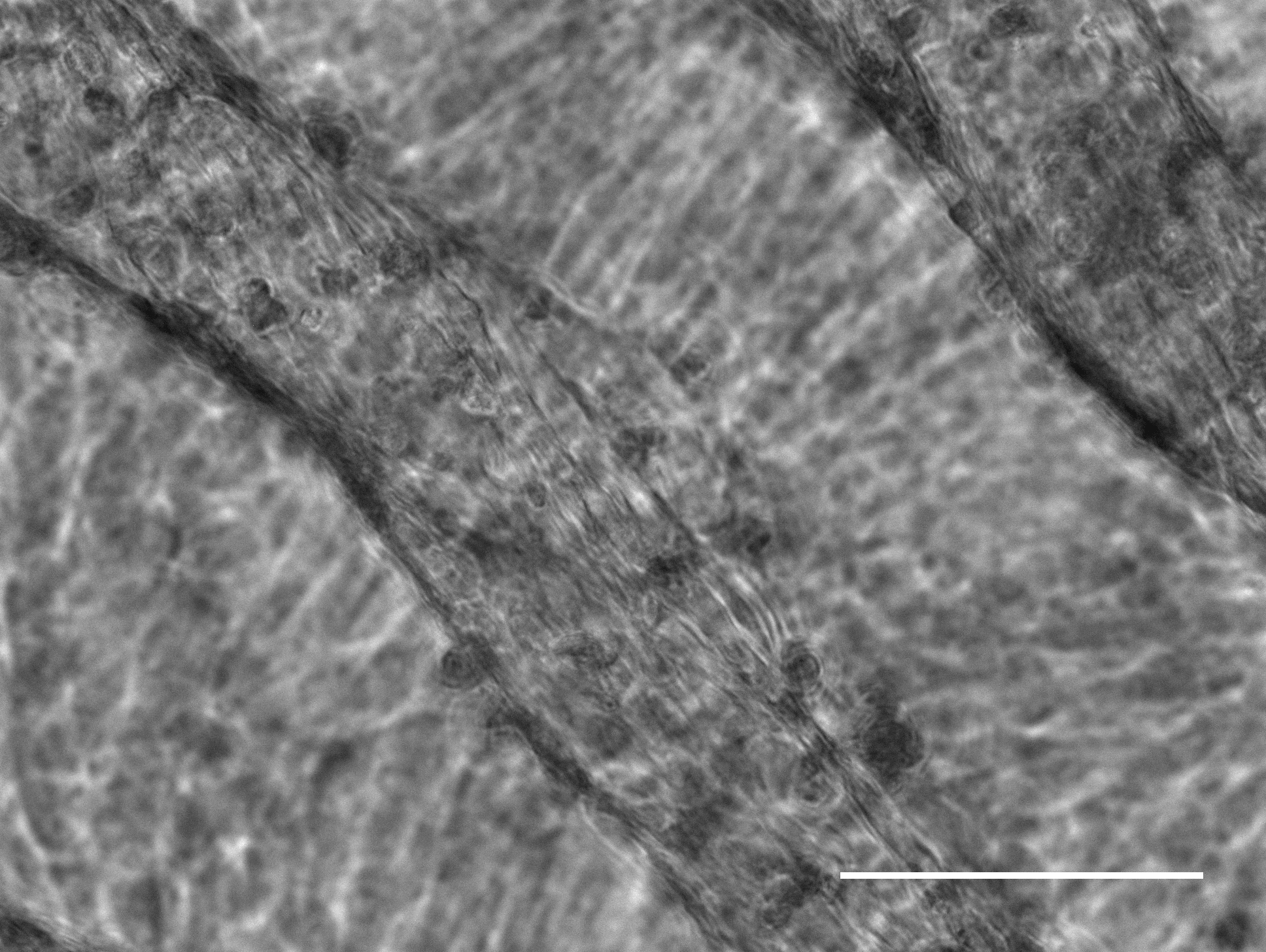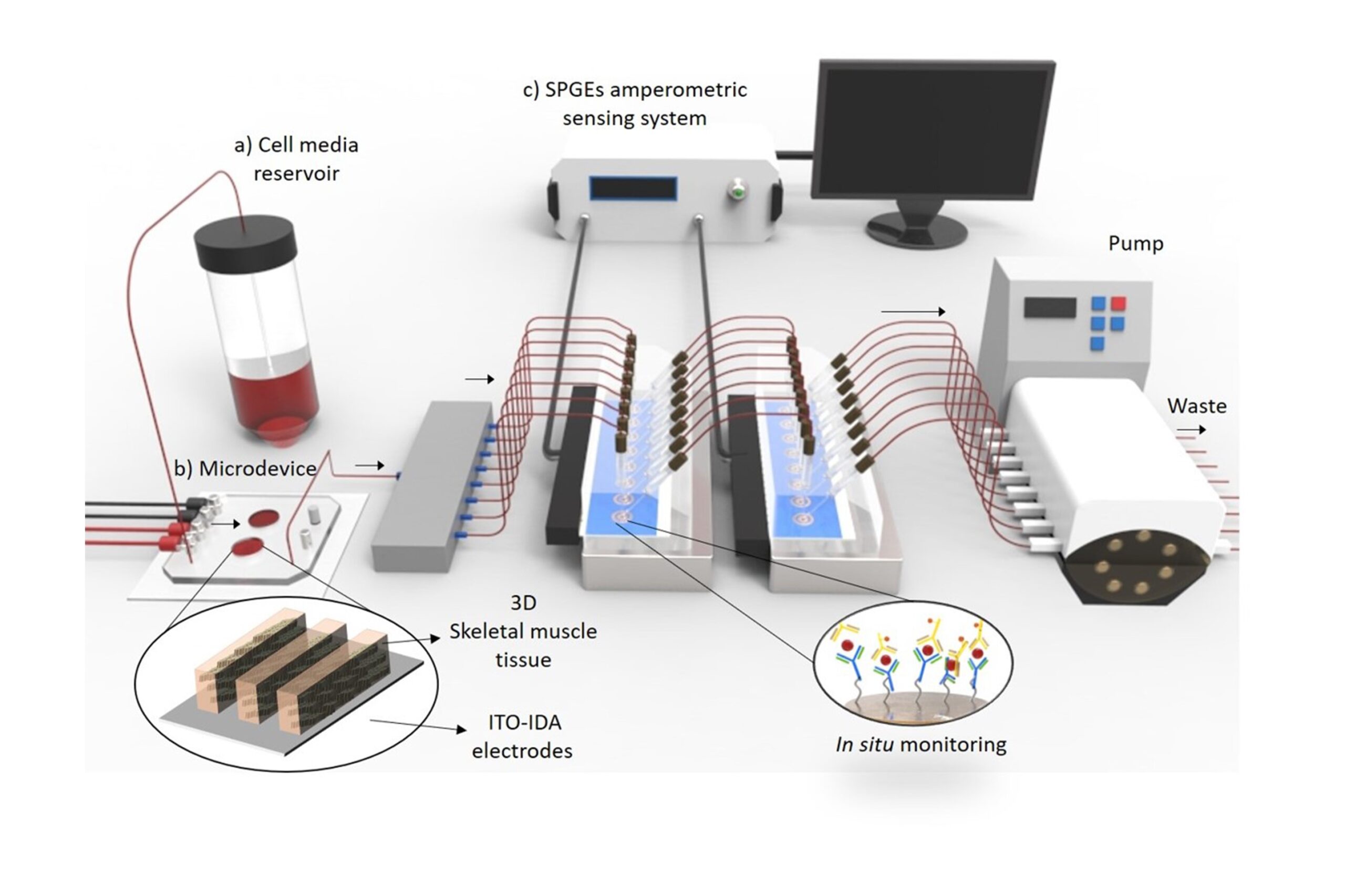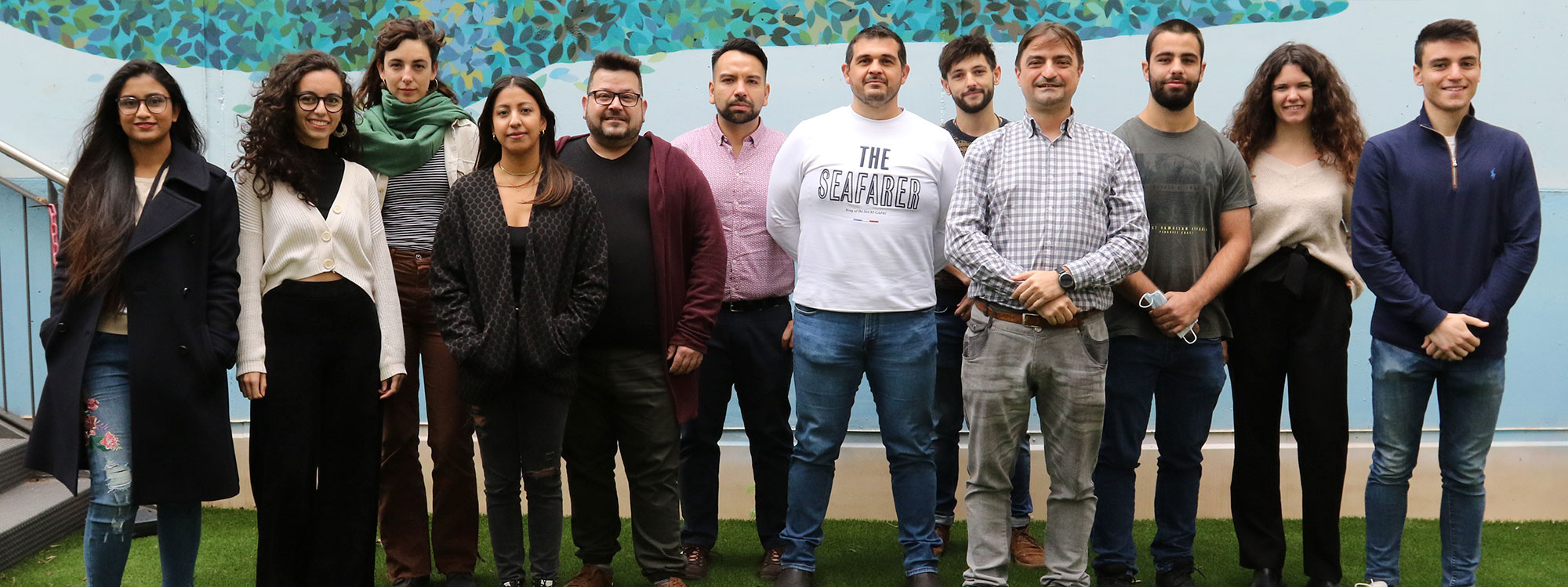About
The Biosensors for bioengineering group is a junior group under IBEC’s Tenure Track scheme.
Our research is focused on multi tissues organs-on-a-chip (OOC) and more specifically in the metabolic crosstalk within tissues and their relationship with metabolic diseases. Our projects are focused on four key tissues regulating glucose homeostasis, namely, the pancreas, liver, skeletal muscle, and adipose tissue. To achieve this objective, it is necessary a combined interdisciplinary approach.

Biomaterials and tissue engineering research
1) We have several lines of research related with skeletal muscle. Our first approach was with C2C12 mice cell line. We evaluated the influence of mechanical stiffness and geometrical confinement on the 3D culture of myoblast-laden chemically modified gelatin photo-cross linkable composite hydrogels in terms of in vitro myogenesis.
2) Encapsulation of beta-cells like from human skin fibroblast (collaboration with IDIBAPS). This work addresses two critical issues in the design of an efficient beta-cell replacement therapy: an accessible cell source for generation of substitute beta-cells and an adequate delivery device for transplantation. On one hand, we propose to generate transplantable functional insulin-producing beta-cells from fibroblasts through direct reprogramming strategies that bypass the pluripotent iPS stage. On a second objective, we are working in a new system of encapsulating beta-cells like in two steps, microencapsulation to protect cells from immune system and microencapsulation to mechanically protect them and manipulate them.
3) We are developing three-dimensional micro liver models using various biomaterials to recreate the in vivo-like mechanical properties and using hepatocytes and stellate cells. We are collaborating with Grifols company to test some drugs in our model.
4) We have a collaboration project with NovoNordisk to work in new approaches to encapsulate retinal cells.
Biosensing technology:
1) Integrating biosensors in an organ-on-a-chip. We are studying with in situ electrochemical biosensors the release of insulin under the effect of external stimuli, changes in glucose levels and myokines secreted by skeletal muscle (multi-OOC approach).
2) Related with this project we are implementing new biosensors systems. To fully exploit the potential of the organs-on-a-chip, there is a need to interface them to integrated sensing modules, capable to monitor in real-time their biochemical response to external stimuli, like stress or drugs. The goal of this project is to answer this need, by developing a novel technology based on integrating localized surface plasmon resonance (LSPR) sensing module to organs-on-a-chip devices to monitor disease and evaluate drug response in organs-on-a-chip models.
3) Myotonic dystrophy type 1 (DM1) (collaboration with Hospital de la Fe and INCLIVA, Valencia, Spain). We have developed human skeletal muscle micro physiological tissues using micro molding technology and we have integrated them with amperometric biosensors to study the inflammatory process related with electrical and chemical stimuli. We have used transdifferentiated skin fibroblast human cells from DM1 patients and healthy human. Using this platform, we have started to evaluate different treatments, to screen drugs and to evaluate doses.
4) NMR integrated with OOC. The objective of this project is to develop a new technology based on magnetic resonance spectroscopy and imaging using dynamic nuclear polarisation (DNP-MR) integrated with OOC devices to monitor disease and evaluate drug response in OOC models. As a proof-of-concept, this project will fabricate a biomimetic multi OOC integrated device composed of liver spheroids and pancreatic islets and develop the necessary DNP-MR hardware and software to study metabolic diseases and for future drug screening applications. We are working in collaboration with Oxford instrument and Multiwave companies.


Staff
Javier Ramón Azcón
Projects
| NATIONAL PROJECTS | FINANCER | PI |
|---|---|---|
| Development of a “Muscle-on-a-Chip” (MoC) platform for the preclinical evaluation of potential therapies for Duchenne muscular dystrophy (2020-2022) | DUCHENNE ESPAÑA, IV Convocatoria Ayudas a Proyectos de Investigación | Juanma Fernandez |
| BLAD · BioLiver Assist Device (2020-2021) | AGAUR, Ajuts per a projectes innovadors amb potencial d’incorporació al sector productiu – LLAVOR | Javier Ramón |
| INNOTEC- Javier Ramon- Naturfiltr (2021-2023) | TECNIO | Javier Ramón |
| ASITOC Atomic-Sensor-Integrated Tissue-On-a-Chip: optically detected biomagnetism to understand muscular diseases (2021-2022) | BIST_Barcelona Institute of Science and Technology | Juanma Fernandez |
| INTERNATIONAL PROJECTS | FINANCER | PI |
|---|---|---|
| DAMOC · ‘Diabetes Approach by Multi-Organ-on-a-Chip’ (2017-2022) | ERC | Javier Ramón |
| BLOC · Benchtop NMR for Lab-on-Chip (2020-2022) | European Comission FET-Open | Javier Ramón |
| PRIVATELY FUNDED PROJECTS | FINANCER | PI |
|---|---|---|
| Tatami · Therapeutic targeting of MBNL microRNAs as innovative treatments for myotonic dystrophy (2019-2022) | Fundació bancaria “La Caixa” | Javier Ramón |
| FINISHED PROJECTS | FINANCER | PI |
|---|---|---|
| Programa Faster Future 2020: COVID-19 (2021) | Fundraising | Javier Ramón |
| INDUCT · Fabrication of a biomimetic in vitro model of the intestinal tube muscle wall: smooth muscle-on-a-chip (2018-2020) | MINECO | Javier Ramón |
Publications
(See full publication list in ORCID)
[br]
Equipment
Micro and nanofabrication techniques:
- 3D microstructures on hydrogel materials
- Mini-bioreactor for 3D cell culture
- Microelectrodes fabrication
- Synthesis and chemical modification of polymers and surfaces
- Dielectrophoretic cells and micro particles manipulation
Characterization techniques:
- Optical Microscopes (white light/epifluorescence)
- Electrochemical techniques (Potentiometric/Amperometric/Impedance spectroscopy)
- Immunosensing techniques (Fluorescence ELISA/Colorimetric ELISA/magneto ELISA)
Equipment:
- Microfluidic systems (High precision syringe pumps/Peristaltic pumps/Micro valves)
- Biological safety cabinet (class II)
- Epifluorescence microscope for live-cell imaging
- Pulsar – a high-resolution, 60MHz benchtop NMR spectrometer from Oxford Instruments
Access to the Nanotechnology Platform (IBEC Core Facilities): equipment for hot embossing lithography, polymer processing and photolithography, chemical wet etching, e-beam evaporation and surface characterization (TOF-SIMS)
Access to the Scientific and Technological Centers (University of Barcelona): equipment for surface analysis (XPS, AFM, XRD), organic structures characterization (NMR) and microscopy techniques (SEM, TEM, confocal)
Collaborations
- Prof. Josep Samitier
IBEC - Dr. Elena Martinez
IBEC - Dr. Anna Novials
Institut d’Investigacions Biomediques August Pi i Sunyer (IDIBAPS) - Dr. Ramon Gomís
Institut d’Investigacions Biomediques August Pi i Sunyer (IDIBAPS) - Dr. Eduard Montanya
The Bellvitge Biomedical Research Institute (IDIBELL) - Prof. Enric Bertran
Physics and Engineering of Amorphous Materials and Nanostructures (FEMAN), Department of Applied Physics, University of Barcelona - Dr. Montserrat Costa
2020, Director Plasma Proteins Research, Bioscience Industrial Group, Grifols, Barcelona Spain, Collaborative project - Tryfon Antonakakis
2019, Co-Founder & CEO Multiwave Technologies AG 3 Chemin du Pré Fleuri 1228, Geneva Switzerland, FET-open project - Robert Hardy
2019, Project Manager Oxford Instruments plc Abingdon, Oxfordshire, England, FET-open project - Dr. Carlos Villaescusa
2018, Principal Scientist/Specialist, Project Leader, Department of Stem Cell Discovery, Novo Nordisk Denmark, Collaborative project
Clinical collaborations
- Project “TATAMI” funded by Fundación Bancaria “La Caixa” – CaixaHealth program. In this project, we are developing a platform to perform drug screening analysis in human engineered microtissues in close collaboration with Professor Ruben Artero from Instituto de Investigaciones Clínicas de Valencia (INCLIVA) and medical doctor Vilchez from Hospital de la Fe (Valencia)
- We are also collaborating with Hospital de Sant Pau (Barcelona), with the group of senior professor Isabel Illa Sendra we are developing human microtissues to study the myasthenia gravis neuromuscular rare disease.
- In a Smart Specialization Project (RIS3CAT, ADVANCECAT project), I am working with senior professor Eduard Montanya from Hospital de Bellvitge (Barcelona) to develop transplantable patches of human pancreatic islets.
- Finally, we are collaborating with Doctor Jesus Castro from Hospital de la Vall de Hebron (Barcelona) to study chronic fatigue.
News
IBEC to Develop Organs-on-a-Chip in Three Pathfinder Projects
BuonMarrow, OMICSENS, and PHOENIX-OoC are the three projects in which IBEC’s Biosensors for Bioengineering Group will apply its extensive knowledge in the field of biosensors and organs-on-a-chip. The projects, which will be developed with funding from the European Innovation Council’s prestigious Pathfinder Open program, promise to enhance cancer treatments and foster innovation in diagnostics.
An artificial muscle to study Duchenne muscular dystrophy
Developed by the IBEC, this system is created using patient cells and represents the first 3D muscle model capable of replicating the damage caused by Duchenne muscular dystrophy. The next phase of this project involves the development of an organ-on-a-chip platform, enabling more efficient preclinical studies of potential drugs and enhanced monitoring of muscle damage. Funding for this research has been provided by Duchenne Parent Project Spain, a non-profit association led by families with children affected by this form of dystrophy.
European funding for the treatment of Type 1 diabetes using 3D bioprinting
IBEC researcher Javier Ramón Azcón has been awarded an “ERC Proof of Concept Grant.” This prestigious funding is granted by the European Research Council to explore the commercial and societal potential of research projects conducted in European institutions. Ramón’s project, Uniink, is centered on the treatment of Type 1 diabetes using cell therapy and 3D bioprinting.
IBEC researcher James Eills to meet with Nobel laureates
Dr. James Eills, researcher at IBEC, has been selected to attend the prestigious Lindau Nobel Laureate Meeting that brings together outstanding young scientists from around the world with Nobel laureates. This year, the event will be dedicated to Physiology & Medicine and will be held from 25th-30th June in Lindau, Germany.
Scientific summit to fight against neuromuscular diseases
Scientists and patients meet at the IBEC to look for new treatment strategies for these minority pathologies. The journal Ara interviewed Juanma Fernandez Costa, postdoc researcher at the group of … Read more
Researchers develop a “gym on a chip” that will help to study diabetes and find new drugs to treat the disease
Coinciding with World Diabetes Day, researchers from the Institute for Bioengineering of Catalonia (IBEC) reveal a study that combines muscle and pancreatic cells on a single chip and demonstrates that … Read more
Bioengineering to treat diabetes in the media
Researchers from the Institute for Bioengineering of Catalonia (IBEC) led by ICREA Research Professor Javier Ramón, appear in the media for a recent study in collaboration with IDIBAPS researchers, in which they have developed small spheres capable of responding to variations in the levels glucose and produce insulin in vitro.
Innovative bioengineered spheres might help treating diabetes
Researchers from IBEC, in collaboration with IDIBAPS in Barcelona, have developed nontoxic small spheres able to respond to variations in glucose levels, and producing insulin in vitro. These biomimetic spheroids containing pancreatic β-cells were prepared based on 3D bioprinting. This approach might help in the future improving clinical outcomes of β-cell transplantation strategies for diabetes treatment, as well as for in vitro drug screening platforms.
14th IBEC Symposium brings international experts and 300 attendees together
International experts and three hundred registered attendees met in the 14th IBEC Symposium, dedicated to regenerative therapies. Organised by the Institute for Bioengineering of Catalonia (IBEC), speakers presented the latest advances in mini-organs, organs on a chip, 3D bioprinting and tissue engineering, among others.
New biosensor detects inflammatory marker in muscle with high sensitivity
In a recent publication in the journal Nanophotonics, IBEC researchers present a new biosensor for the direct and sensitive detection of the protein interleukin-6 in muscle, an indicator of inflammation and potential disease, proving the high performance of the device on bioengineered 3D skeletal muscles. This new approach may result in a promising tool for measuring the efficacy of drug candidates for diseases where inflammation is present such as muscular dystrophy.
Jobs
Postdoctoral Researcher at the Biosensors for Bioengineering Research Group
Ref: PR_JR/Deadline: 09/12/2023
Postdoctoral position at the Biosensors for Bioengineering Research Group
Ref: PD_JR/ Deadline: 10/11/2023
Laboratory Assistant at the Biosensors for Bioengineering Research Group
Ref: LA_JR/Deadline: 22/11/2023
Laboratory Technician at the Biosensors for Bioengineering Research Group
Ref: LT_JR//Deadline: 28th April 2023


 ibecbarcelona.eu
ibecbarcelona.eu